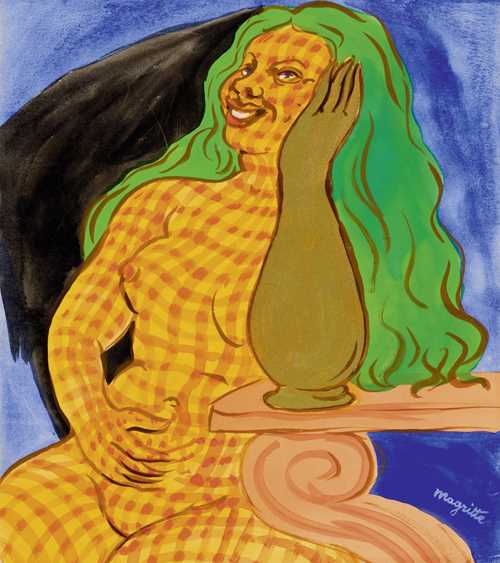
Lotto 3235 - A189 Impressionismo e arte moderna - venerdì, 28. giugno 2019, 17h00
RENÉ MAGRITTE
Provenance:
- Sotheby's, London, auction 16 April 1975, lot 108.
- Private collection, Switzerland, bought at the above auction.
Exhibitions:
- Paris 1948, Magritte. Peintures et gouaches, Galerie du Faubourg, Paris, 11 May - 5 June 1948.
- Brussel 1968, Dix maîtres contemporains, 28 June - 31 August 1968, no. 50.
- Milan 1970, Schubert, no. 3.
- Knokke 1971, Brachot, no. 9.
Literature: David Sylvester, Catalogue raisonné de l'Oeuvre de René Magritte, Menil Fondation, 1994, vol. IV, p. 107, no. 1270 (with ill.).
"The German occupation marked the turning point in my art. Before the war, my paintings expressed anxiety, but the experiences of war have taught me that what matters in art is to express charm. I live in a very disagreeable world and my work is meant as a counter-offensive.” (quoted in S. Gablik, p. 146).
Shortly after the end of the Second World War, Magritte experimented with a new style of painting, referred to as his "Période Renoir" or "Période soleil". Unlike in his previous works, Magritte sought to express “the beautiful side of life” in an impressionistic style in the manner of Renoir. These paintings, which greatly differed from the artist’s previously shown Surrealist works, were met with strong rejection.
“I do not ask you [. . .] to copy old paintings, but to perpetuate the poetic and mysterious quality of your earlier paintings, which in their tight technique are much more “Magritte” than those in Renoiresque colour and technique, which everyone thinks are outmoded,” wrote art dealer Alexander Iolas in November 1947, when he was unable to find buyers for Magritte's works. The answer followed one week later. Magritte announced the end of the "Période Renoir”, and in preparation for his first solo exhibition in Paris, he intensively prepared the paintings and gouaches of the so-called "Période Vache".
In a short time frame of only five weeks at the end of 1947 and beginning of 1948, Magritte produced for his exhibition in Paris at the Galerie de Faubourg a series of paintings and gouaches that reflect a brash, expressionistic, inflammatory and grotesque style that was completely new to the artist's oeuvre. Inspired by popular image sources such as caricatures and comics, interspersed with art historical allusions to artists such as James Ensor, Edouard Manet or Henri Matisse, the artist executed circa 17 oil paintings and 20 gouaches in a quick and rough manner. The name "Période Vache", which Magritte himself gave to this creative period, was an ironic allusion to the Fauve artists, who had been derogatorily called "wild beasts" due to their use of bold colours. Magritte's unmistakable exaggeration of colour during this phase also cannot be overlooked.
Resulting from the fact that the Brussels Surrealists, with Magritte, and the Parisian Surrealists, with André Breton, had clashed more than once before the war, together with the fact that Magritte's first solo exhibition in Paris, the birthplace of the Surrealist movement, did not come to fruition until 1948, Magritte saw this exhibition as a chance for revenge on his French colleagues. “In 1948 he gets the opportunity to exhibit, to deliver. [. . .] Since leaving Paris in 1931, the city has shown him the cold shoulder — just as they irritate, ignore everyone who lives outside the wall. [. . .] That was exactly the moment for the decisive blow. Not for a minute did the question arise of showing pictures in one established way or another. [. . .] Above all, the important thing was not to enchant the Parisians, but to shock them.” (Scutenaire, Avec Magritte, p. 109.)
Magritte deliberately conceived the exhibition as a provocation of the Parisian public. With more or less concrete side blows and critical references, he lampooned the Parisians in their "narrow-minded Parisian self-image as a bastion of high culture" and made fun of his French colleagues. (René Magritte, La Période Vache, p. 81).
The work offered at auction, "Les voies et moyens”, unmistakably belongs to the works of "Période Vache" and is an excellent example of the artist’s strong use of colour and the irony of his thoughts. The striking chequer pattern of the body reappears in different variations in many works of this period, as does the uncharacteristic use of gold colour found in the “vase arm" in our work. With these "pseudo-decorative" stylistic elements, Magritte criticises the pleasing "salon painting" and, in his opinion, the dangerous approach of the Surrealist avant-garde at that time. For the present work, there is also a preliminary drawing as well as an oil painting of differing colour.
Although Magritte did not sell one single work during the exhibition, he achieved his goal. The Parisian public was shocked and appalled by the nearly 40 works. Until 1961 none of the works of the "Période Vache”, apart from one painting, were shown in an exhibition. It was not until the 1980s that the pictures began to be integrated into exhibitions and eventually, in Marseille and Frankfurt, exhibitions were dedicated exclusively to this creative period.
Magritte himself must have experienced a tremendous euphoria in the preparation for this first exhibition in Paris. His close confidant Scutenaire confirmed that he had never seen the artist so exuberant, as he explained, "these are works of brilliant freedom in which the boldest thoughts, the handwriting and the illumination make frightful noise, where impudence intermixes with esprit, indignation with amazement, violence with tenderness, wisdom with jest.”
CHF 250 000 / 400 000 | (€ 257 730 / 412 370)
Venduto per CHF 439 500 (incl. premio dell'acquirente)
Non si assume alcuna responsabilità per la correttezza di queste informazioni.


